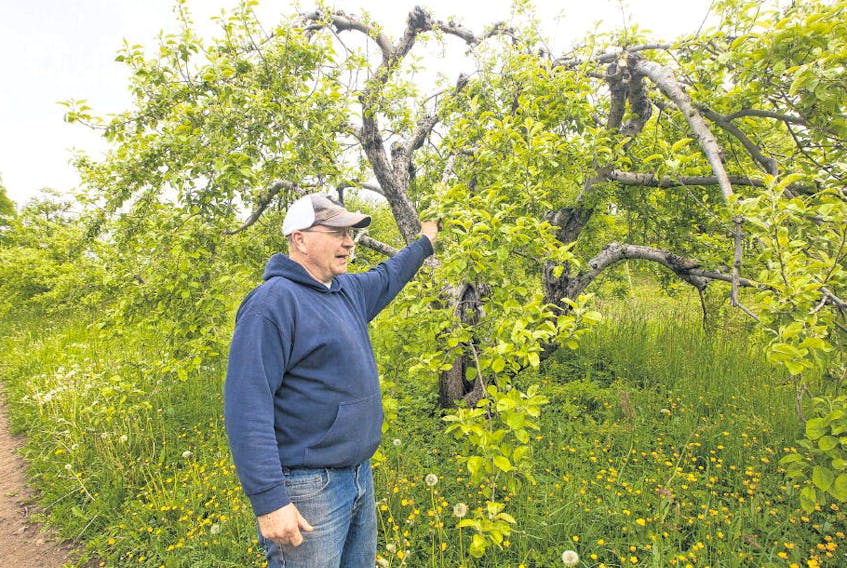In one cold morning, Nova Scotia’s crops were dealt their worst blow in living memory.
Blueberries, apples, pears, peaches, plums, potatoes, corn, grapes . . . every crop that was in bloom was hit hard when the temperatures plummeted early Monday morning.
“Probably one of the worst times in history (of Nova Scotia agriculture),” said Keith Colwell, Nova Scotia’s agriculture minister.
“It’s going to take a few weeks to really nail down the damage but hopefully it’s less than it appears to be.”
On Monday morning, Environment Canada measured a temperature of minus four degrees in Stewiacke and minus 1.9 degrees in Kentville (the lowest since it began keeping records a century ago).
“In the (30 years) I’ve been in this gig, I’ve never seen such a widespread killing frost in June,” said Saltwire meteorologist Cindy Day. “All three Maritime provinces were hit.”
Though broad, the impacts were unevenly felt.
On breathless nights, cold air sinks and sits in low areas. So at Spurr Brothers Farms near Kingston, along the floor of the Annapolis Valley, Lisa Spurr measured a temperature of minus 3.5 degrees early Monday morning.
For an orchard caught in bloom, minus 2.2 degrees will result in a 10 per cent kill of blossoms while minus 3.9 degrees will mean 90per cent destruction. “For us it was significant damage,” said Spurr.
“. . . We will have to give it a couple weeks to assess the full extent of the damage.”
Also located on the valley’s floor, at the apple and spice farm between Waterville and Berwick, Lloyd Dicks had written off his crop.
“I’ve been doing this for 18 years and I haven’t seen anything like it,” said Dicks. “We’re some of the lucky ones because we aren’t carrying debt.”
The valley floor normally benefits from a week’s head start on the growing season because it is warmer.
On the North and South Mountains that form the valley’s walls, many growers got some protection as the cold air drained away from them.
Larry Lutz’s 44 hectares of apples and peaches in Rockland, near the highest point of South Mountain, are about 150 metres higher in elevation than either Spurr’s or Dicks’ farms. He didn’t see any damage to his blossoms.
“It’s a common misperception that apples are only sensitive when in full bloom,” said Lutz, who is president of the Nova Scotia Fruit Growers Association “Apples are sensitive from the time buds start to swell in March or April, right on till the fruit is the size of a golf ball.”
Most orchards in the valley have crop insurance that is subsidized by both the provincial and federal governments.
In the blueberry industry, already suffering after two years of historically low prices, the damage might be far worse.
“Unmitigated disaster,” said Cumberland County blueberry farmer Jeff Orr of the damage.
“Unmitigated because when you have already suffered losses from the previous two crops and then you invested money you don’t have into your next crop and then it gets wiped out.”
Orr estimates he’s suffered a 50 per cent loss on the fields he’s been able to check, but others have been completely wiped out. He said that because prices have been so low, many didn’t buy crop insurance as a way to cut losses.
Also, some growers got bills instead of cheques last year when their fields were harvested by Oxford Frozen Foods.
There is also now the threat of an outbreak of botrytis blight among the remaining blossoms.
“Are we in a situation where there needs to be some kind of disaster relief?” said Orr.
“I think we’re probably there. To not do anything right now puts a lot at risk.”
Colwell said that subsidized crop insurance is therelief the provincial and federal governments offer to afflicted farmers but in order for it to work, growers need to have signed up and paid
their premiums.
He added that Department of Agriculture staff will be working with farmers across the province over the coming weeks to assess the damage and see what else can be done.
“It’s like having a major pileup on the highway,” said Colwell. “It will now take some time to sort out what the damage is.”
On Wednesday night, the temperatures were again expected to dip down below the freezing point in some areas of the province, threatening blossoms that haven’t already been killed.
We can thank a low pressure system east of the Labrador coast sucking cold air down toward the Maritimes for the abnormally cold spring temperatures.
“This kind of system is more typical of April,” said Day.
And the misery, though likely in a less destructive form, can be expected to hang on until the end of June.









